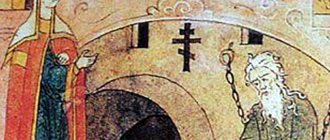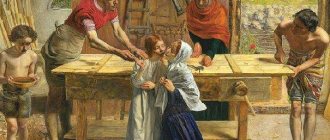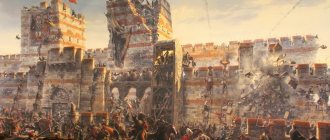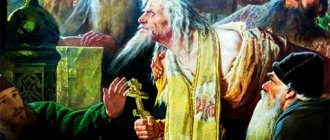Avvakum and Nikon
Becoming
Both heroes of our article and the entire Russian history of the 17th century were born on the territory of the modern Nizhny Novgorod region.
The distance between the native villages of Avvakum and Nikon – Grigorovo and Veldemanovo – is only 14 kilometers. A boy named Avvakum was born on December 5, 1620 in the family of the priest Peter Kondratyev. As the archpriest himself later described in his autobiography, his father was prone to alcohol abuse, while his mother led a pious lifestyle, prayed a lot and observed fasts. As a child, Avvakum witnesses the death of a neighbor's cattle. Then for the first time he thinks about the meaning of life and about death, which no one can avoid. Against the background of external piety (father is a priest, mother is a zealous Christian), Avvakum poses questions of human existence from an early age. This moment in life emphasizes the awareness of faith in God and the subsequent suffering that the priest consciously undertook in the future. At the age of 15, Avvakum is left without a father, and two years later he finds a life partner, Anastasia, whose image deserves special attention and, perhaps, will still enter the pantheon of Russian female heroines.
The peculiarities of church life and priestly service were known to the young son of the late priest, and soon Avvakum accepted the rank of shepherd. He begins his ministry in the village of Lopatitsy.
The future patriarch was born 15 years earlier than his opponent. He was baptized with the name Nikita. The boy's mother died early, and his relationship with his stepmother did not work out. According to his own testimony, the woman beat Nikita and starved him to death. Despite the difficulties in the family, the boy improved in the study of the Bible and literacy. To do this, Nikita goes to the Makariev-Zheltovodsky Monastery and lives in the bell tower. 8 years of stay in the monastery were not in vain: after getting married, Nikita becomes a priest. The first place of service of the future patriarch is the Mother See.
In rank
After the death of his children, Father Nikita decides to become a monk. The priest persuades his wife to do the same, and he himself goes to the Solovetsky Monastery. Nikita Minin takes monastic vows from the Monk Eleazar of Anzersky with the name Nikon. For his active disposition, the new resident of the monastery receives from the saint obedience to perform divine services and manage economic activities. The conflict with Saint Eleazar forces Nikon to go to the Kozhezersky Monastery in the Arkhangelsk region. There, the fugitive monk successfully moves up the church ladder and soon becomes the abbot of the monastery.
According to tradition, Abbot Nikon was obliged to come to Moscow for the presentation to the Tsar. At that time, the country was ruled by Alexei Mikhailovich from the Romanov family. Nikon managed to impress the king. This served as the point of a new takeoff: the abbot of a distant northern monastery, by order of the monarch, was elevated by Patriarch Joseph to the rank of archimandrite of the Novospassky Monastery in Moscow.
What kind of life did the priest Avvakum live during that period? He received a village parish in the Nizhny Novgorod region, where he began active pastoral service. Habakkuk was committed to strict observance of liturgical regulations and the moral law. In his life more than once lines flashed about the dissatisfaction of part of the flock with long services and furious denunciations. To our contemporary, Habakkuk in such a context may seem like an evil fanatic, but in reality he was only the man whom the era required. Descriptions of the priest and other authors of the 17th century only confirmed the decline of the morals of Russian society. Habakkuk strove to fulfill the burden of shepherding placed on him, but no more.
One day, a young priest had to intercede for a girl whom the local governor had taken from her widow. What did the sovereign's husband allow himself to do? Using official powers for personal gain? Why did he need a young beauty? The answers that come to mind only make you sadly silent. The only one who found the courage to try to prevent lawlessness was Father Avvakum. For this he was beaten by the governor and the archers, and the priest’s house, in which the priest tried to hide, was literally stormed using firearms. But the governor released the girl.
One day a girl came to confession to Father Avvakum. She confessed to the sin of fornication. It must be said that confession in the ancient Russian tradition differed from the modern one. It was often performed privately, one-on-one, without haste or pressure from the queue lined up at the lectern. Usually people came to confession at a pre-agreed time, on a weekday or evening. What he heard from the confessor inflamed passions in Avvakum himself. To put down the fire raging inside, the priest held his hand over the fire of the lamp, received a burn, but got rid of the obsession.
Avvakum was loved by ordinary people for his kindness and inflexibility in religious beliefs. But the “fiery archpriest” was not popular among the governors and boyars. Or rather, he used it – so much so that he was forced to flee to Yuryev-Povolsky. But even from there, after a massive attack by the local “bohemia,” seeking protection and support, Father Avvakum headed to Moscow. The priest believed that in the capital he would find spiritual, educated, literate people who, like him, seriously cared about the moral state of the Russian people.
God-lovers
In Moscow, Nikon, with his characteristic activity, joins the informal movement of “zealots of piety.” Authoritative representatives of the clergy of the capital and dignitaries close to the royal court, like others like them in all centuries, were convinced that they were living in an era of the deepest spiritual crisis of their own people.
Even under Patriarch Filaret, a reform began to unify liturgical books, called the “book right”. The arrival of Christianity in Rus' was accompanied by active translations of Greek texts. They had minor differences, but did not lose the essence of the content. Russian scribes also used similar patterns, working with different sources, and possibly making mistakes and creating discrepancies. To be fair, it should be said that the differences were minimal: it could concern only a few words, their spelling, or simple typos and grammatical errors. The advent of printing presses helped eliminate such shortcomings. The Greeks carried out their “right” in the 16th century by organizing the printing of book editions in Catholic Venice. After the fall of Constantinople and the entry of the Greeks into the Union of Florence with the Catholics, state and church leaders of Rus' only strengthened in eschatological sentiments and the confidence that now Moscow is the Third Rome. The church-state symphony became not a pathetic statement, but an act of mutual support, attention, care, and increased responsibility in conditions when Russia was becoming the only independent Orthodox state. How could there be any trust in books printed on a Catholic press?
Therefore, in Russia the “right” moved independently, carefully and carefully, regardless of what was happening among the Greeks. This process was slow and “survived” two patriarchs: Philaret and Joasaph I. During the presidency of Joseph, the situation took a more liberal course. If previously only old Russian texts were sources for editing, now Greek ones took their place. The problem was that already reformed books were taken as a basis.
Avvakum, once in Moscow, was able to become friends with the confessor of Tsar Alexei Mikhailovich Stefan Vonifatiev. Thus, future opponents found themselves in a circle of zealots of piety, united by one cause. Nikon had by that time become a metropolitan, and the hour of his patriarchate was already close. A boy from a peasant family with a difficult childhood, who experienced the burden of injustice, escaped “to the top” thanks to his will and perseverance. The Eastern Patriarchs, who often visited Moscow on humanitarian missions to raise funds for the needs of the persecuted, poor and oppressed Greek dioceses, convinced both the Tsar and the Patriarch of the need to take upon themselves the feat of patronage over all Orthodox peoples. The Ecumenical Patriarch – this is how the Greek hierarchs pictured Nikon’s future. With full support from the king.
“A book is a sacred object in the life of a Russian person”
A book is a sacred object in the life of a Russian person. Entrusting the “right” to strangers, people with unknown internal attitudes and compromising religious beliefs is a crime. This is exactly what Patriarch Nikon did, replacing the Russian monks-inquirers with Polish ones led by Arseny the Greek. The latter was an adventurer who at different times changed his faith to Catholic or Muslim, depending on how circumstances required it. Avvakum, watching what was happening along with members of the circle of zealots of piety, was shocked by Nikon’s decisions. This was just the beginning.
Reforms and links
Archpriest Avvakum served in the Kazan Cathedral in Moscow and sharply opposed the innovations. Very quickly he found himself in the basement of the Andronikov Monastery. Thanks to the intervention of the king, who treated the archpriest with great respect, Avvakum was sent to serve in Tobolsk.
And Patriarch Nikon continues reforms. On the eve of Lent in 1653, when believers traditionally expect temptations, the two-fingered sign of the cross is prescribed to be replaced with a three-fingered one. The Council of the Hundred Heads in 1551 directly postulated the only possible form of the sign of the cross - with two fingers. But the Grecophilia that began to manifest itself in Nikon took its toll. At the Moscow Council of 1654, the patriarch literally “pushed through” changes in the approach to “book reference”: from now on, Greek books of the 16th century became the models for comparison. Two years later, at the next Council, all those signified by two fingers... were anathematized. There have never been such precedents in the history of Orthodoxy. Nikon expelled all those who disagreed from the Church. Cursing. And launched an irreversible process of split. The Russian Church wisely abolished the curses on the “old rituals” as absolute madness in 1971.
Nikon rapidly abandoned the proven Russian church heritage, which had harmoniously developed over 600 years. Greek vestments, the struggle with icons and the sign of the cross, the “correction” of liturgical books - all this accompanied the activities of the tough-minded patriarch. He was a man who sought to leave his mark on history. He succeeded. In addition to reforms, Nikon conceived one after another grandiose construction projects of monasteries. The reshaping of church life kept pace with the desire to cover the space of Russia with holy monasteries.
Archpriest Avvakum, meanwhile, went to Transbaikalia with his wife and children for his convictions. Two of his children died along the way. The priest's family was part of the expeditionary force, which was headed by Ataman Pashkov, a cruel man. Avvakum was not afraid to denounce the governor, for which he was often beaten or taken into custody. The exile, which lasted a total of more than 10 years, was torture, but it did not break the archpriest. He was sincere in his actions and only preached Christ, denouncing iniquities. And he adhered to Tradition, as the Apostle Paul commanded. When Archpriest Avvakum returned to Moscow as a victor in 1663, much in the life of the Church and Russia no longer looked the same.
Rise and Fall
Alexei Mikhailovich was friendly with Patriarch Nikon, made concessions to him, called him a friend, a great sovereign, and allowed him to rule the country during his absence from the capital. Nikon, distinguished by his rudeness and intransigence, quickly made enemies among the Moscow boyars. This played an important role in his future fate.
Relations with the tsar gradually deteriorated, and in 1658 Nikon simply left Moscow. The Patriarch settled in one of the monasteries he built. But demonstrative behavior led not to strengthening positions, but to irritation of the king. In 1666, at the Great Moscow Council with the participation of the Patriarchs of Alexandria and Antioch, Nikon was deprived of the patriarchal and generally priestly ranks and exiled to the Ferapontov Belozersky Monastery in the territory of the present Vologda region.
At the cathedral, Archpriest Avvakum was condemned and cut off. By that time, the irreconcilable priest had plenty of patrons and admirers. Avvakum was the confessor of Boyarina Morozova, a person close to the royal court. Respect among the people for the priest, who never lived a day of his life in the bliss of comfort, but only served, preached and suffered in the most literal sense for his religious beliefs, only grew. The exile to Pustozersk, where Avvakum would spend the last 15 years of his life and be executed, became only a logical page in his difficult but colorful life.
Nikon died in 1681, a year before Archpriest Avvakum was burned in the log house. The defrocked patriarch returned to the New Jerusalem Monastery.
Instead of a conclusion
The life stories of Archpriest Avvakum and Patriarch Nikon are so complex, connected, contrasted and woven into the dramatic events in the Russian Church of the 17th century that they gave rise to more than one serious work exploring the biographies and characters of both heroes. The controversy surrounding the identities of these persons still continues. Unfortunately, this fact only testifies to the ongoing tragedy of the split. Researchers tend to state that the “reforms” in the form in which they took place were absolutely unnecessary. The leisurely “bookish movement on the right”, which has been practiced in Russia since the time of the Council of the Hundred Heads, at some point turned into an authoritarian reshaping of the entire church life. Why exactly Patriarch Nikon, as the head of the Church, became the conductor of these disastrous changes is unknown. And how fate brought the most ordinary priest from the Nizhny Novgorod outback to the forefront of protest against destructive “reforms” also remains a mystery.
The Russian Church spent several centuries recovering from the wound of the schism, finally recognizing the decisions of Nikon and the councils that took place under him as erroneous. Old Believers have the opportunity to reunite with the Church on the rights of One Faith, which happened on the eve of the revolution and slowly, but is happening today. Against the backdrop of events surrounding the schism caused by Constantinople in world Orthodoxy, the figures of Habakkuk and Nikon again emerge into the arena of historical memory. “The Greeks are not our Gospel,” said Tsar Ivan the Terrible. Alas, Patriarch Nikon, with undeniable talents and gifts, extensive activities for the benefit of the Church, succumbed to outside influence. The simple Russian priest Avvakum showed loyalty to Tradition.
You can applaud the author (at least 10 times)38
Exile
The Siberian exile lasted 10 years. During this time, Avvakum and his family went from a relatively prosperous life in Tobolsk to the terrible Dauria - as the Transbaikal lands were called at that time. Avvakum did not want to humble his stern, unyielding disposition, everywhere he exposed the sins and untruths of his parishioners, including the highest-ranking ones, angrily denounced Nikon’s innovations that reached Siberia, and as a result he found himself further and further from the inhabited lands, dooming himself and his family to more difficult living conditions.
In Dauria, he found himself as part of the detachment of governor Pashkov. Avvakum wrote about his relationship with this man: “Either he tormented me, or I did not know.” Pashkov was not inferior to Avvakum in severity and toughness of character, and, it seems, set out to break the stubborn archpriest. Not so. Avvakum, repeatedly beaten, doomed to spend the winter in the “icy tower”, suffering from wounds, hunger and cold, did not want to humble himself and continued to brand his tormentor.
Martyr
In Pustozersk, Avvakum spent 14 years in an earthen prison on bread and water. Other prominent figures of the Schism - Lazarus, Epiphanius and Nikephoros - served their sentences with him. In Pustozersk, the rebellious archpriest wrote his famous “The Life of Archpriest Avvakum.” This book became not only the brightest document of the era, but also one of the most significant works of pre-Petrine literature, in which Avvakum Petrov anticipated the problems and many techniques of later Russian literature.
In addition to the Life, Avvakum continued to write letters and messages, which left the Pustozersk prison and were distributed in different cities of Russia. Finally, Tsar Fyodor Alekseevich, who replaced Alexei Mikhailovich on the throne, became angry at one particularly harsh message from Avvakum, in which he criticized the late sovereign. On April 14, 1682, on Good Friday, Habakkuk and three of his companions were burned in a log house.
The Old Believer Church venerates Archpriest Avvakum as a martyr and confessor.
RESULTS OF ACTIVITY
- Until the end of his life he remained faithful to the old faith, did not accept Nikon’s church reform, and led the Old Believer movement in Russia.
- He created bright, talented works, glorifying faith, high moral qualities of a person - everything that he fought for all his life. Avvakum is considered the founder of a new type of literature - figurative, emotional, confessional. His statements about people’s relationships with each other, about love for one’s neighbor are still relevant.
- He remained in the memory of the people as an example of serving his ideals, values, unbending will and fortitude. It is no coincidence that on the monument to M.O. Mikeshin “The Millennium of Rus'”, opened in Novgorod in 1862, Avvakum is given one of the places of honor, and in 1916 the Old Believer Church canonized him.





